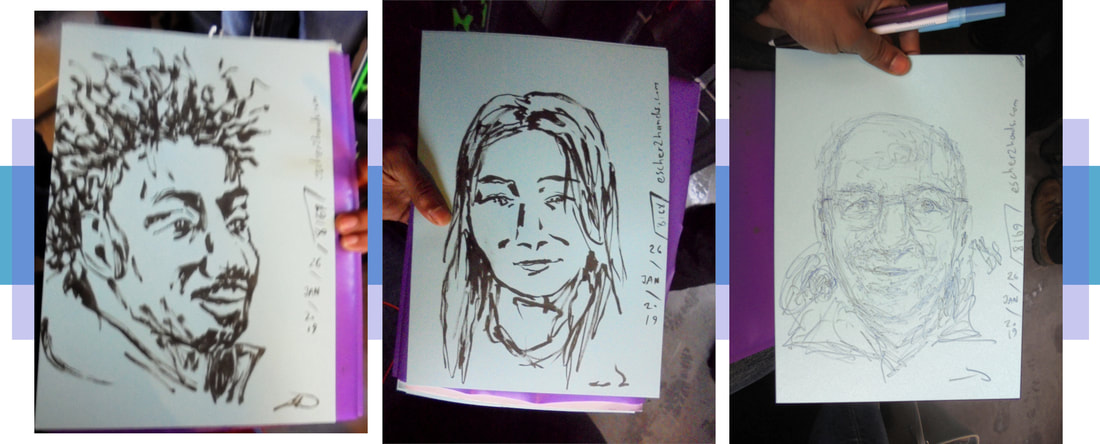‘Punctual, like the trains in Germany.’ The train is delayed by fifteen minutes. Then, the train is cancelled. People huddle in jackets, scarves, hats and gloves on the platform. When we finally get on the red regional train to the big city, it’s full with two train’s worth of people. So there is nowhere to sit.
I draw a few people, standing up. I can only use one hand, so I alternate with each portrait: one with my right hand, one with my left. They’re still defrosting from the long wait in the cold. Someone soon lets me use his giant suitcase as a table. Both hands make good use of it. An older couple can’t stop watching me. They can’t stop talking about me. I manage to draw one of them, before our train reaches its final destination. They wish me good luck.
I draw a few people, standing up. I can only use one hand, so I alternate with each portrait: one with my right hand, one with my left. They’re still defrosting from the long wait in the cold. Someone soon lets me use his giant suitcase as a table. Both hands make good use of it. An older couple can’t stop watching me. They can’t stop talking about me. I manage to draw one of them, before our train reaches its final destination. They wish me good luck.
I make it in time for our lunch appointment. Living far from friends means we have to schedule these kinds of things. The line to the restaurant stretches far into the sidewalk on a freezing afternoon, but that’s no big deal. Once we’re waiting inside, it’s warm. I take a seat with my friends in the crowded reception area. I draw a family that, like us, is waiting for a table. As I draw each young daughter, they run over to show their dad. They proudly display their portraits to their grandma. Their dad gives me a nice smile. We get a table. We enjoy four delicious bowls of piping hot ramen.
| Some friends take the subway. I head to the tram with another friend. We pass the little girls and their family on our way. They’re still holding the beige sheets of paper I drew their faces on, dancing in the cold. “How’d you learn to draw people like that?” my friend asks, as we board our tram. Practice. We sit down. Our ride is short. I draw a man dozing off, wearing a cap. Everyone is watching. People are talking. “…und mit beiden Händen!” (“…and with both hands!”) I can hear in conversations all around me. I stand up and quietly wake the man: Entschuldigung… he opens his eyes. Ihren Porträt. Ein Geschenk (excuse me…your portrait. It’s a gift). He looks at me, then the portrait. Everyone starts smiling. He starts smiling. An old lady starts clapping. Everyone starts clapping. “Do you draw like this everyday?” One of the old women asks. Yes. |
My friend and I get off. He’s never seen me draw in a train before. I was lucky he joined me on a day I received an ovation. As we talk, two Kurdish men from the tram approach me. “Could you...also draw my picture?” one of them asks. I ask my friend if he’d mind. Sure, I tell them.
We find a café there in the station. They buy me a cappuccino. We take a seat on the long couch and I draw their pictures. A balding man with glasses can’t stop staring. His mouth hangs open the entire time I draw. My hands move fast now, warm and comfortable. I draw both men, then their girlfriends from photos they share with me, before I cap my pens; before I return my folder to its place in my bag. I make my way to leave. The balding man looks up. He points at his face. I close my eyes and smile. OK. I take my paper and pens out again. I draw one more portrait in this coffee shop. He can’t stop admiring it.
I find the big red train that will take me home. I walk past each train car, surveying which will have the most faces for me to draw; which will have the best possibility for interesting conversations. I pick a seat, and realize I know the girl across from me. I drew her only two weeks ago! She was an artist herself, and drew me too. I smile at her. She recognizes me too.
I draw a young couple. “…und mit beiden Händen!” says an older woman near us. Naturally, I draw her next. We talk of studies and work and my experiences being new in Germany. I set my eyes on someone sitting a bit farther from us. I draw her picture. I hand it to her. Ano…kimi wa nihonjin desuka? (um…are you Japanese?) “Ehhh? Yes I am!” she answers. I change seats. I sit next to her and her boyfriend. There are no Japanese people in my small town. A chance to practice like this is a rare treat, I explain. She watches my hands move, mouth open as I draw her boyfriend. “…Ryou te de!” (“…With both hands!”) she exclaims, at least a few times. “I find it amazing you can talk and draw at the same time,” the boyfriend tells me, in German. No, the hard part is drawing and speaking in Japanese at the same time, I explain. I get a few minutes of practice in. What I can’t say in Japanese I explain in German, the gears of language in my brain shifting with less friction now. Kore wa watashi no eki desu, (this is my stop), I say, telling them goodbye. “Hopefully we’ll meet again,” the Japanese woman responds.
The doors open and I step off the train. I put on my jacket, scarf, hat, and gloves at the platform. I head home.





 RSS Feed
RSS Feed